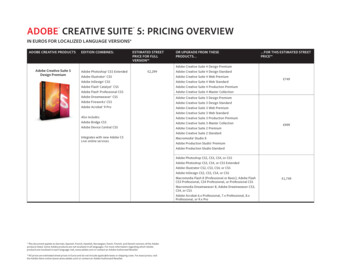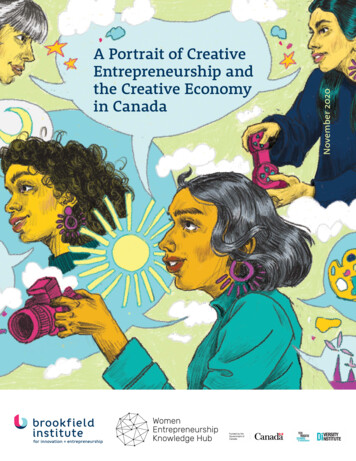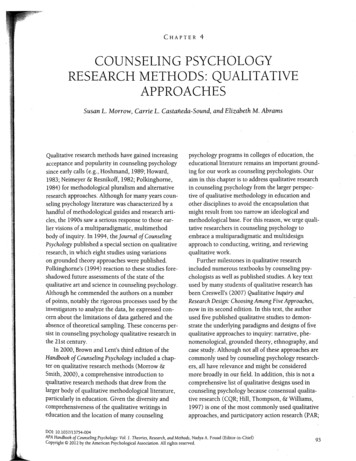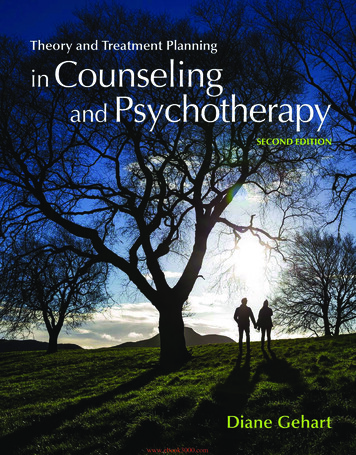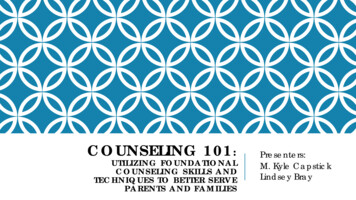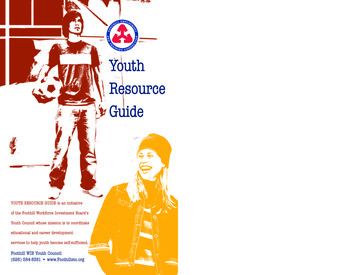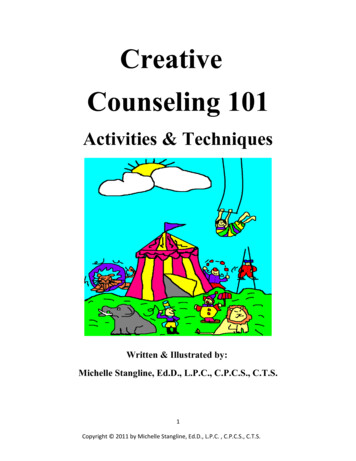
Transcription
CreativeCounseling 101Activities & TechniquesWritten & Illustrated by:Michelle Stangline, Ed.D., L.P.C., C.P.C.S., C.T.S.1Copyright 2011 by Michelle Stangline, Ed.D., L.P.C. , C.P.C.S., C.T.S.
Dedication:For my family: Thank you for all the love and support given to me while I worked on mycareer in counseling. I would never be where I am without you! A special thanks to myhusband, Barry. You have opened up an entire new world for me by way of writing andillustrating my books. I love you!Acknowledgments:This book was written for my past and future students that I teach in on the Master’s levelin counseling at Mercer University and Argosy University in Atlanta. This book wascreated for all the counseling students and working mental health professionals who do notknow what to do with children, adolescents, teens, and adults in counseling. It was alsocreated for the seasoned counselor who wants new ideas and new ways to help clients on adeeper level. The activities in this book can be used with children, adolescents, teens, andadults. By using these activities and techniques you will allow your clients to gain a deeperunderstanding of themselves and the way they relate to the world around them. The clientsand students that have used these techniques have benefited tremendously in their owncounseling process.Copyright 2011 by: Dr. Michelle Stangline, E.d.D., L.P.C.2Copyright 2011 by Michelle Stangline, Ed.D., L.P.C. , C.P.C.S., C.T.S.
Table of ContentsIntroduction:Creative Counseling Philosophy: Using CreativeCounseling for your clients:Page 3Chapter 1Creating the Creative Counseling Room:Page 9Chapter 2Warm-up Techniques for Creative Counseling:Page 13Chapter 3Make Your Own Creative Counseling Tools:Page 23The Sand Tray, Doll House, Puppet Theater, & PuppetsChapter 4Use of Miniatures in Creative Counseling:Page 31Chapter 5Expressing Feelings with Creative Counseling:Page 36Chapter 6Creating Personal Worlds with Miniatures:Page 95Chapter 7Using the Sand Tray and Mandala:Page 134Chapter 8Therapy Games, Groups, and Bibliotherapy:Page 144Chapter 9Closure: Ending Creative Counseling:Page 155About the Author & IllustratorPage 159*Disclaimer: The activities in this book are meant to be used by a licensed mental healthprofessional or a certified school counselor. If you are a mental health professional who doesnot have training in the creative play and arts arena it is strongly recommended to seeksupervision with someone who is trained in the creative arts and play therapy. Do not attemptto use these activities in this book without proper training, or ongoing supervision with atrained professional. If you, or your client(s) becomes suicidal, or homicidal when using anyof the activities listed in this book contact your nearest mental health hospital or call 911.3Copyright 2011 by Michelle Stangline, Ed.D., L.P.C. , C.P.C.S., C.T.S.
Introduction:My name is Dr. Michelle Stangline and I am a Creative Psychotherapist. I haveworked as a psychotherapist in many settings. These include school counseling,clinical counseling and private practice, and as mental hospital counselor. I amalso an adjunct professor at two major universities. At Mercer UniversityAtlanta, I teach Play Therapy, Sand Tray therapy, Ethics and LifespanDevelopment. At Argosy University in Atlanta I teach supervision to studentsduring their Master’s Counseling Internship. I also offer workshops to mentalhealth professionals in the area of Play Therapy and Sand Tray Therapy. I loveto work with adults in order to help them get in touch with their inner child oradults who have lost their creative edge. I also have a strong background in artand use my skills in creativity every day. I am certified in Art Education andSchool Counseling and my doctorate degree is in Counseling Psychology. Ihave been a teacher and counselor for the past fifteen years.The great masters of psychotherapy that have greatly influenced my life andwork include Albert Ellis, Carl Jung, Alfred Adler, Anna Freud, and ErwinYalom, Gary Landreth, and Eliana Gil. Anna Freud was one of the firsttherapists to work with children. Carl Jung was the first to process the archetypepersonalities. You will see a lot of his beliefs in the miniature work and sandtray activities.The creative counselor is an eclectic counselor. I cannot put myself into oneschool of psycho therapeutic thought. I take bits and pieces of many schools oftherapy. When I work with a client I allow the client to take me where they needto go. If I do not have the understanding or training for the necessary tools I goand seek the proper training and supervision in order to help my client reachtheir full potential. I find that being creative is the most helpful aspect in mygrowth as a psychotherapist. This book is a conglomeration of my journey as acreative seeker of knowledge in the field of psychotherapy, art, travel and life.My journey and training has given me many tools in order to better serve myclients and students.4Copyright 2011 by Michelle Stangline, Ed.D., L.P.C. , C.P.C.S., C.T.S.
While working as a college professor helping to prepare Master’s LevelCounseling interns, I found that these students did not understand how towork with children. Many universities do not offer any training to counselingstudents in the area of Creative Arts and Play Therapy.My belief is that every counseling student needs to have some formal trainingin the area of creative play and arts. I also know that when we learn how to workwith children on their level it also teaches us how to work more creatively withadults. Most of my work with adults is based on a modified creative play andart therapy curriculum.I also believe that any psychotherapist can do what we call “talk therapy”. Buttalk can be cheap and talk therapy does not always take a lot of training. Yearsago, in my own analysis as a counseling student in graduate school, Iremember needing more than “talk therapy” from my counselor. I went toseveral counselors seeking a deeper level of awareness. While searching for thisdeeper awareness in therapy I found myself thinking, “Is that all you’ve got ?Give me more than that! I need to process on a deeper level!”Sadly enough, my personal counselor(s) could not take me where I needed to goto a deeper level. It takes a creative counselor, one with training and a naturalinstinct, to really help clients reach a deeper level of self-awareness. All of theactivities in this book have been successfully completed with children,adolescents, teens, and adults. The activities are very visual in nature. Usingthese activities allow the client to go to the deepest part of the brain (See ReptileBrain Dysfunction for more information). They help client’s visualize theirissues, confront themselves, and find working solutions to these issues.This book is a basic tool to help the beginning counselor understand and utilizethe creative arts and play therapies. It is also useful for the seasoned counselorwho might have a client that is stuck, or needs to process on a deeper level.The activities are easy to use and materials can be purchased cheaply. Mystudents know that I am always calling myself “cheap” as a joke. What I mean5Copyright 2011 by Michelle Stangline, Ed.D., L.P.C. , C.P.C.S., C.T.S.
by this is that I do not spend a lot of money on tools for clients. I believe the besttools are homemade or very inexpensive. You will see many items you can makefor your clients in this book. These items are often made from recycledmaterials and barely cost any money.Creativity is the key to making creative tools in psychotherapy for your clients.I also offer free clip art on my website for therapist to use as tools for clients. Byusing clip art and your computer / printer, you do not have to clutter up youroffice or play room. The therapist can also find the perfect miniature for theclient using this method. One no longer has to collect thousands of miniaturesin hope that one of these miniatures will benefit a client for an activity. Theclient can also gain more visual understanding about themselves bycompleting the activities. The book activities can be used for individual or groupwork.I wish I had found a tool similar to this book when I was a new counselor. Myfirst job as a counselor was working in a mental institution. As I reflect backon my work with this population I find that I am saddened by the fact that theynever got a chance to do any of these activities to help them on their difficultjourney. I believe that the activities in this book would have promoted healingand hope to so many of my clients who were suffering from mental illness inthe mental institution.For those people not suffering from a mental illness this book can be used forthe “healthier” client, or for individuals who want to learn how to be more creativeand find solutions to problems in everyday life. The therapist will also have fundoing these activities by themselves before using them on their clients (This ishighly recommended, as I believe a therapist should always use a tool onthemselves before using it on a client.)The activities are tried and true and have been used for many years in theschool and private counseling setting. They work in the “counseling arena” forthe private practice psychotherapist and the school counselor. These activities can6Copyright 2011 by Michelle Stangline, Ed.D., L.P.C. , C.P.C.S., C.T.S.
also be modified for use in the school setting for shorter groups and individualsessions.This book can also be used in to the therapeutic and clinical side of counseling.Many extensions have been added to the activities for those on the clinical sideof counseling for that therapist wishing to give their clients a richer experiencein psychotherapy.Is this book based on directive therapy? In a sense yes it is based on directivetherapy. I was a teacher for many years before I became a therapist. Mytraining as a teacher always taught me to be prepared in advance with a lessonplan. My training as a psychotherapist taught me that if the activity I hadplanned was not applicable to the client’s need in the therapy session then itmust be disregarded. The client must always lead the way in counseling. Thejob of the psychotherapist is to have excellent training and be eclectic in theirapproach to psychotherapy.Often students who are involved in an internship are asked to do things that awell seasoned therapist would do. These students would often go into groups“cold” without any type of plan or activity. The only knowledge these studentspossessed was “talk therapy.” Remember, talk is cheap and anyone can go intoa session (individual or group) and just “talk”. It is hard to do psychotherapywithout some type of plan. Creative Psychotherapy is directive and non-directiveat the same time. I would not want to go to my medical doctor and have himshow me around his examination room to entice me to “find” tools for mydiagnosis. I want my medical doctor to know what he is doing and to bedirective with me in a plan to help me with my illness.A psychotherapist must be the one who has the training and the tools to helpclients. It is not up to the client to find the tools that they need to helpthemselves. However, I do try to sense what my clients like to do beforesuggesting an activity. A few of my clients do not like to touch the sand;therefore we do not do any sand tray activities. I follow my clients lead and gowhere the client needs to go, not where I want to go. This is how I use non7Copyright 2011 by Michelle Stangline, Ed.D., L.P.C. , C.P.C.S., C.T.S.
directive therapy with clients. Yet, I am the one who has the expertise, training,and tools to help clients. This is part of what I get paid for. I do not sit back andlet the client choose what tools will be used unless they want to. Directive andnon-directive therapy is a fine line and which one is used must be used based onthe needs of the client, not the therapist. Also, with managed care, therapists areoften confronted with the client only being able to have brief therapy sessions.One must plan and be directive with a shortened client treatment plan.I often plan ahead for the next session at the end of the current session. After theclient leaves I take notes as to what I think would be an effective activity for theclient at the next session. As I am thinking of the activity in the “currentsession” I will make the suggestion to the client about the activity. If the clientis open I plan the activity for the next session. This allows the client to thinkabout the suggested activity and I find that clients are excited to come for thenext session due to the activity we have planned.This book gives activities and ideas for those just starting out inpsychotherapy, or for those wanting fresh ideas that will expand theirknowledge base in therapy. It can be used for all ages. Adolescents, teens, andadults enjoy these activities as much as children do. Use these activities for allages, individual sessions, or group sessions.I hope you enjoy this book and remember that play and creativity is a universalright for all human beings (child, adolescent, adult).Regards,Michelle Stangline8Copyright 2011 by Michelle Stangline, Ed.D., L.P.C. , C.P.C.S., C.T.S.
Chapter OneCreating the CreativeCounselingRoom9Copyright 2011 by Michelle Stangline, Ed.D., L.P.C. , C.P.C.S., C.T.S.
The Creative Counseling RoomThe creative counseling room is slightly different from a play therapyroom or an art therapy room. This room combines play and art elements,however, it is not cluttered with toys or massive amounts of art supplies. I do notconsider myself just a “play therapist”, or just an “art counselor”. I combinemany types of psychotherapy in the creative arts arena. These include the sandtray, art, play, bibliotherapy, music, miniatures, and drama therapy. I use thefive senses in creative counseling with my clients. Client’s are able to use thesense of smell by the lingering scents of gingerbread, lavender, lemon,peppermint, cinnamon and chocolate chip cookies.Clients see a well organized room that is visually pleasing to the eye. The roomis attractive to the child as well as the teen and adult. They can listen tobeautiful sounds such as the rainforest, whales, or a visual imagery c.d. Myclients can touch all the objects in the room. Nothing is off limits to them and Iencourage the client to explore. They can taste cookies (see the feeling cookie)and sugar (see Sugar Therapy).Below are some of the things you will see in my creative counseling room:PuppetsTreasure BoxBlocksHomemade Made WandsCelebration BoxHomemade Puppet TheaterBooksHomemade Doll Houses (Several)GamesBooksAffirmation JarCookies & LollipopsHomemade Sand TrayC.D.’s for Music and Visual ImageryPlastic Sand Tray for making a Wet Sand TrayClip art Cutouts10Copyright 2011 by Michelle Stangline, Ed.D., L.P.C. , C.P.C.S., C.T.S.
Artwork (My personal artwork that is child centered, never show the clientswork to others as it violates confidentiality.)Several Miniatures of different genres (See Miniature Section for descriptions)Art Supplies (Glue, glitter, confetti, paper, scissors, crayons, colored sand, tape,Play Dough, wooden dowels, paper dolls, markers, pipe cleaners, fake gems, etc.)My Traveling Creative Counseling Tools:I often travel to serve the needs of clients.1 large traveling crateBags of miniatures: I love the tubes of animals such as jungle, reptiles, farm,ocean, and circus miniatures.Art supplies (glue, glitter, popsicle sticks, markers, crayons, paper, confetti,sequins, fake gems, ribbons)Puppet Supplies (Paper towel holders, construction paper, small moveable eyes,pipe cleaners)Paper Plates & Card StockPlay DoughAffirmation JarSlinkysBubble BottleKaleidoscopeCopies of activities in this book (have an idea of what you will use but bringextra activities in case the client needs something else.)Small Empty Boxes11Copyright 2011 by Michelle Stangline, Ed.D., L.P.C. , C.P.C.S., C.T.S.
Selected booksMagazine’s that relate to a client’s personality (for making paper dolls)Traveling Sand TrayClip art Cutouts (Computer with access to clip art)12Copyright 2011 by Michelle Stangline, Ed.D., L.P.C. , C.P.C.S., C.T.S.
Chapter TwoThe Beginning of theTherapy Process:Warm Ups &TechniqueswithCreative Counseling13Copyright 2011 by Michelle Stangline, Ed.D., L.P.C. , C.P.C.S., C.T.S.
Creative Treasure BoxRationale: Sometimes clients need visual tools to help them see their world in adifferent way, or deal with stress or anger. I buy many of the items below fromOriental Trader on-line and keep them in a Treasure Box. I also allow childrenand teens to take an item out of the Creative Treasure Box at the end of eachsession.Materials:1 Treasure boxAssorted items such as a slinky, bubble bottles, kaleidoscopes, warm fuzzies,mood rings, etc.Directions:1. Have the client state the problem and begin to process the situation at hand.2. Assess the situation to see if it is stress or anger issue. Show the client theCreative Treasure Box. Allow them to pick one item in the box to take home.3. Refer to the activity worksheets in this chapter for the slinky, bubble bottle,mood ring, kaleidoscope, warm fuzzy, stress ball, or golf ball.4. Give the client the inexpensive item to take home as a visual reminder andcoping skill.14Copyright 2011 by Michelle Stangline, Ed.D., L.P.C. , C.P.C.S., C.T.S.
The Kaleidoscope (A Different Perspective)Rationale: Sometimes clients need a tool to help them see their personal world ina different way. The kaleidoscope can help clients imagine a different ways oflooking at things, especially when they see a kaleidoscope distort reality. Thiscan also be a calming technique for clients when they look into themagnificence of the kaleidoscope. I buy kaleidoscopes in bulk from OrientalTraders or the Dollar Store. I keep these in my creative toy box to offer clients atool for looking differently at the world.Materials:- One small party favor kaleidoscope or a dollar store kaleidoscopeDirections:1. Have the client state the problem and begin to process the situation. Ask theclient if they have looked at this situation from every angle.2. Give the client a kaleidoscope to look through. Ask the client what they see.Discuss how the kaleidoscope can give a distorted view of reality. Ask the clienthow they might be distorting the situation?3. Continue to process the “crooked thinking” that the client might beexperiencing. Transfer that thinking into ways to create a new perspective thatthe client can master.4. Give the client the inexpensive kaleidoscope to take home as a reminder tokeep seeking new ways to look at the problem.15Copyright 2011 by Michelle Stangline, Ed.D., L.P.C. , C.P.C.S., C.T.S.
5. An extension of this is to have an expensive kaleidoscope in your office. Theseare truly an experience to look through.16Copyright 2011 by Michelle Stangline, Ed.D., L.P.C. , C.P.C.S., C.T.S.
Blowing Bubbles (Anger, Anxiety, Stress)Rationale: I keep several inexpensive bubble bottles in my creative toy box. I usethis as part of a stress or anger management technique for children,adolescents, teens, and adults. I buy my bubble bottles from Oriental Trader.Materials: 1 Bubble Bottle with wandDirections:1. Show the client how to dip the wand in the bubble liquid and blow the bubblesout.2. Ask the client to try visual imagery and imagine blowing out negativefeelings and thoughts. When the client breathes in, ask them to think of happy,calming thoughts.3. Give the client the bubble bottle to take home and practice each day for tenminutes for stress, or to use when they feel angry feelings.17Copyright 2011 by Michelle Stangline, Ed.D., L.P.C. , C.P.C.S., C.T.S.
Fiddle Basket (Warm Up / Anxiety)Rationale: This is a great way to begin conversations with clients of all ages. Ikeep this basket on a table close to where the client sits. In this basket there is anassortment of items for the client to pick up and “fiddle” with. These items caninclude the slinky, bubble bottle, balloon, golf ball, kaleidoscope, rocks, shells,and some miniatures. I often change out the miniatures and add otherinteresting items.This “fiddle basket” can get the client talking, usually by the client asking mequestions about the items in the “Fiddle Basket”. If they ask about a certainitem, it shows me a path that they are interested in taking. For instance, if theystart to play with the slinky, I ask if they would like to have a slinky to use forstress management. I have learned that what the client picks up in the basket isusually something that represents a visual for what is going on in their lives orsomething they need.There is always a reason why clients are interested in a certain item in theFiddle Basket. However, this “reason” or “need” is usually on a deepersubconscious level. One time I had a fake plastic “poop” in the basket. I had ateen tell me that their life was “crap” and they felt like the “poop”. Needless tosay, this was a great conversation starter.Materials: Basket with an assortment of items that are small such as a stressball, kaleidoscope, slinky, balloon, bubble bottle, golf ball, rocks, shells, andassorted miniatures.18Copyright 2011 by Michelle Stangline, Ed.D., L.P.C. , C.P.C.S., C.T.S.
Directions:1. Put the “Fiddle Basket” within the client’s reach before the session.2. If the client shows an interest, invite them to “play and fiddle” with the itemsin the basket.3. Let the client lead you. If they happen to take interest in an item found inyour Creative Treasure Box let them know you have one they can take home.4. See activities for the slinky, golf ball, balloon, kaleidoscope, Warm Fuzzy,and stress ball.5. For each session change the items in the Fiddle Basket to keep it fresh.19Copyright 2011 by Michelle Stangline, Ed.D., L.P.C. , C.P.C.S., C.T.S.
Golf Balls (Anxiety, Stress, Anger, A.D.H.D.)Rationale: I discovered the significance of the golf ball when I was taking myfinal statistic class in graduate school. After struggling to understand whatthe teacher was talking about I tried rolling a golf ball in my hands (under thedesk of course.) I found this a very soothing technique and very helpful to mypre-frontal cortex. I felt as if I could listen more effectively and betterunderstand the difficult material. I keep a golf ball in my “Fiddle Basket” forclients to try as a relaxation technique.Materials: 1 Golf BallDirections:1. Using both hands, show the client how to roll the golf ball up and down theinside of the hands.2. Notice the calming effect the indention on the ball has for stress reductionand relaxation.3. Try this with your A.D.H.D. patients. Students can use this at school or whilecompleting homework. However, if it becomes a toy it needs to be put away for awhile until the student can learn to handle it correctly.20Copyright 2011 by Michelle Stangline, Ed.D., L.P.C. , C.P.C.S., C.T.S.
The Slinky (Anger, Stress, Anxiety)Rationale: In my creative box I keep several inexpensive slinkies from the dollarstore, or from Oriental Trader. I give this out to children, adolescents, teens, andadults for stress and anger management, or to use as a distraction.Materials: One inexpensive slinky toyDirections:1. Give the client a slinky. Tell them they can take it home and keep it.2. Show the client how to pull the slinky back and forth for stress release.3. Explain that while you pull the slinky back and forth you are watching itintensely. This can help with stress and anger as your attention is “distracted”towards the slinky.4. Count to ten as you work the slinky back and forth.5. I give this to students who are anxious at school. They can take the slinky toschool, but it cannot become a toy while being used at school. It is important toexplain this concept to the parent, child, and teacher. If it becomes a toy then theteacher needs to take it away and give it back to the child at the end of the day.21Copyright 2011 by Michelle Stangline, Ed.D., L.P.C. , C.P.C.S., C.T.S.
Stress Ball (Anger, Stress, Anxiety)Rationale: I keep an assortment of stress balls in my creative treasure box. Ialso have an activity that I use to let clients make their own stress balls below.Materials: One stress ball, or make your own stress ball: 1 balloon w/ sandDirections:1. Using both hands show the client how to squeeze the stress ball when angryor frustrated.2. Notice the calming effect the ball has for stress reduction and relaxation.3. To make a stress ball simply add sand to a balloon and create a ball shape.Tie the balloon to keep the sand in.22Copyright 2011 by Michelle Stangline, Ed.D., L.P.C. , C.P.C.S., C.T.S.
Chapter ThreeHomemade ToolsInCreativePsychotherapy23Copyright 2011 by Michelle Stangline, Ed.D., L.P.C. , C.P.C.S., C.T.S.
Homemade Puppet TheaterRationale: Children often prefer homemade creations in the play room. An oldpicture frame makes a great puppet theater. Make sure it is safe to use, is selfstanding and will not fall on children. Use your imagination and make surethe stage looks appealing to children. You may wish to include child friendlyfabric for the curtains.The Puppets:Create puppets out of socks, paper, or materials for your puppets. Puppets can bemade or store bought. Finger puppets may also be used. Again, make the puppetkid friendly! Marionettes may also be used. See the puppet making activity foradditional puppet making ideas.Materials:Large Picture FramePaintWooden DowelFabricStitch Witchery found in craft storesDirections:1. Paint the picture frame with the color of your choice.2. Cutout fabric curtains. Make room for the wooden dowel to attach on top ofthe curtains. You can sew the ends by using Stitch Witchery and an iron.Attach the fabric to the wooden dowel with Stitch Witchery or by sewing.3. Attach the long dowel to the puppet theater with nails.24Copyright 2011 by Michelle Stangline, Ed.D., L.P.C. , C.P.C.S., C.T.S.
Homemade PuppetsRationale: Children like to make puppets, especially if it looks just like them!Have your client make a self-portrait puppet and allow them to take it home.Keep several paper towel and toilet paper holders on hand for children to makeand take home. This is a great activity for your young client to project his orher feelings onto a puppet and confront other puppets. Mix your own playtherapy puppets with the child’s homemade puppet to create the ultimate puppetshow!Materials:Paper towel or toilet paper cardboard holders or socksWiggly eyesYarnColorful paperScissorsGluePipe Cleanerslarge popsicle sticksDirections:1. Cover the toilet or paper towel cardboard holder with paper of choice.2. Color in the face with nose, eyes, and ears.3. For the eyes clip a small portion of the pipe cleaners. Glue to the eye area.Take the wiggly eyes and glue to the end of the pipe cleaners. This will give theeyes definition and a 3 D appearance.4. Add yarn of choice for hair.25Copyright 2011 by Michelle Stangline, Ed.D., L.P.C. , C.P.C.S., C.T.S.
5. Add clothing with paper or markers. . Large Popsicle sticks can be added forthe base of the puppet.Paper Towel Puppet idea created by two of my best students:Lyndsey Morda and Angelie Greene. Permission granted to use idea byAngelie and Lyndsey.26Copyright 2011 by Michelle Stangline, Ed.D., L.P.C. , C.P.C.S., C.T.S.
Create Your Own DollhouseRationale: A therapist does not have to go out and purchase an expensive dollhouse. Many times children prefer the homemade dollhouse verses the storebought dollhouse. I have several doll houses that I have made by myself. Theyare often simple, and some are made from old bookshelves.Materials:-Wood, cardboard, shoe boxes, boxes, or heavy card stock, plastic, or a bookshelfto convert.-Building materials such as: glue, nails, scissors, or a saw- Furniture & decor (Make or buy)- Dollhouse family or miniaturesDirections:1. Using the material you have chosen create the dollhouse you desire.2. Make it as child friendly as possible. Children like color and sparkle.3. Create doors, windows, and any other embellishments you desire.4. Make your own or purchase furniture for your dollhouse.5. Include miniatures or dolls meant for a dollhouse.Your final grade for this project is based on your creativity, time, and effort putinto the dollhouse. Make sure you create it with your own hands. Do not pay for27Copyright 2011 by Michelle Stangline, Ed.D., L.P.C. , C.P.C.S., C.T.S.
someone to build you a dollhouse. You will also want to include miniatures thatrepresent your family of origin and your inner child.28Copyright 2011 by Michelle Stangline, Ed.D., L.P.C. , C.P.C.S., C.T.S.
Build Your Own Sand TrayRationale: The sand tray is a great way to use miniatures and to get clients toopen up and let the therapist into their phenomenological world. I encourage mygraduate students to build their own sand tray to save money. I do not likeusing my dry sand tray with water. I offer a plastic tray for the use of waterwhen a client needs to use a wet tray.Official Size of the Sand Tray: 20 x 30 with a 4 inch depth.Materials:Base: 1 Particle Board sheet: 20”x 30“(1/2 inch thickness)2 Particle boards: 20 inches (short sides)2 Particle boards: 30 inches (long sides)NailsSand paperBlue paintWood stain PolyurethaneDirections:1. Put the sand tray together as a rectangle with the wood sheet at the base andthe particle boards as the sides. Sand the wood down to make the tray smooth.2. Paint the tray entire tray (except for the inside part) with the wood stain.Allow to dry.3. Use craft glue and nail to secure the sand tray.4. Paint the bottom and insides of the sand with the blue paint. Allow to dry.29Copyright 2011 by Michelle Stangline, Ed.D., L.P.C. , C.P.C.S., C.T.S.
5. Cover the entire tray with the polyurethane paint (This will protect the tray’spaint). You may wish to
School Counseling and my doctorate degree is in Counseling Psychology. I have been a teacher and counselor for the past fifteen years. The great masters of psychotherapy that have greatly influenced my life and work include Albert Ellis, Carl Jung, Alfred Adler, An


